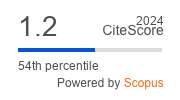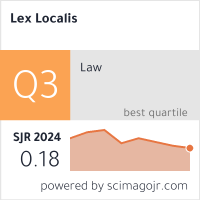Administrative Authority-driven Public Engagement: A Case Study of Local Government’s Commendation Governance in China
DOI:
https://doi.org/10.4335/21.4.729-749(2023)Keywords:
public engagement, China local government, evaluation and commendation, engagement mechanism, governance performanceAbstract
In recent years, China’s central government has focused strategically on motivating local governments to allocate more administrative resources to enhance performance in non-economic areas, such as environmental and cultural services. As a governance practice, the central government has initiated “evaluation and commendation” campaigns among local governments. The main governance objective of these local government campaigns is to solicit public engagement, including public participation, support, and actions. Based on a case study of the campaign to establish a National Civilised City, this paper presents the local government’s governance logic, operating mechanism, and governance performance in soliciting public engagement in “evaluation and commendation” activities. We find that in “evaluation and commendation” campaigns, characterised by short-term authority commendation incentives and shortage of governance resources, the local governments adopted the unusual governance mechanism of “administrative authority-driven public engagement”, using both flexible and mandatory strategies. The flexibility strategy leads to the active participation of citizens, but the mandatory strategy makes public engagement stay at the superficial level, characterised by surface-level cooperation and inner rejection, causing partial exclusion and separation between the government and the public, in turn exhibiting a “ratchet effect” in governance performance.
References
Aghion, P. & Tirole, J. (1997) Formal and real authority in organizations, Journal of Political Economy, 105(1), pp. 1-24.
Andrew, G. W. (1995) Local governments as industrial firms: An organizational analysis of China’s transitional economy, American Journal of Sociology, 101(2), pp. 263-301.
Archon, F. (2015) Putting the public back into governance: The challenges of citizen participation and its future, Public Administration Review, 75(4), pp. 513–522.
Boix, C. & Posner, D. (1998) Social capital: Explaining its origins and effects on governmental performance, British Journal of Political Science, 28(4), pp. 686-693.
Bao, G.X. & Zhou, Y.F. (2010) Chinese Government Performance Evaluation: Review and Outlook, Science and Technology Management, 31(07), pp. 105-111.
Bovaird, T. (2008) Urgent Strategic Management and Planning Mechanisms in Complex Adaptive Systems, Public Management Review, 10(3), pp. 319-340.
Chen, Q. (2018) Forming and role dilemma of “public welfare operator ”: A study on the role of rural grass-roots government in China in the transition period sociological studies, Sociological Studies, 33(2), pp. 88-114, 244.
Chen, B. & He, M. (2021) The Implementation Logic of Local "Evaluation and Commendation" from the Perspective of Composite Governance: Taking the Co creation of Four Cities in D City, S Province as an Example, Journal of Beijing University of Technology (Social Science Edition), 23(06), pp. 110-118.
Deutsch, K. W. (1961) Social Mobilization and Political Development, American Political Science Review, 55(3), pp. 493-514.
Dickson, B. J. (2007) Integrating wealth & power in China: The Communist Party’s embrace of the private sector, China Quarterly, pp.192.
Dickson, B. J. (2003) Red capitalist in China: The Party, private entrepreneurs and prospects for political change. (Cambridge: Cambridge University Press).
Edwards, B. & Foley, M.W. (1998) Social capital and civil society beyond Putnam, American Behavioral Scientist, 42(1), pp. 124-140.
Fu, Y. (2007) Zhang Yan’s Chinese decentralization and structural bias in fiscal expenditure: The cost of competition for growth, Managing the World, 3, pp. 4-12, 22.
He, Y. L. (2020) Straightening out the relationship and shaping the national governance structure, Chinese Social Sciences,1, pp. 38-58.
Huang, X. C. & Zhou, L.A. (2019) “Twinning competition”: A new mechanism of urban grass-roots, Governance Innovation Society, 5, pp. 1-38.
Jin, H., Qian, Y. & Weingast, B. R. (2005) Regional decentralization and fiscal incentives: Federalism, Chinese style, Journal of Public Economics, 89(9-10), pp. 1719–1742.
Jing, Y. & Savas, E. S. (2009) Managing collaborative service delivery: Comparing China and the United States, Public Administration Review, 69(s1), pp. 101-107.
Jing, Y. J. & Gong, T. (2012) Managed social innovation: The case of government-sponsored venture philanthropy in Shanghai, The Australian Journal of Public Administration, 71(2), pp. 233–245.
Jing, Y. (2008) Outsourcing in China: An exploratory assessment, Public Administration and Development, 28(2), pp. 119–128.
Li, Z. (2014) As an evaluation and commendation model for tournament mobilization officials: Take the “create a healthy city” campaign as an example, Journal of Shanghai Jiaotong University (Philosophy and Social Sciences Edition),22(05), pp. 54-62.
Montinola, G., Qian, Y. L. & Weingast, R.B. (1996) Federalism, Chinese style: The political basis for economic success, World Politics, 48(1), pp. 50-81.
Ni, X. & Yuan, C. (2014) How does the sports governance of local government move towards “regularization”?: Analysis on the Special Action of S Municipal Supervision Bureau, Public Administration Review, 2, pp. 70-96, 171-172.
Perry, E. J. (2002) Moving the masses: Emotion work in the Chinese revolution mobilization, An International Journal, 7(2), pp. 111-128.
Putnam, R. (1993) Making democracy work: Civic traditions in modern Italy (Princeton: Princeton University Press).
Qu, J. D., Zhou, F. Z. & Ying, X. (2009) Sociological analysis from general domination to technical governance: based on China’s 30 years of Reform experience, Chinese Social Sciences, 6, pp. 104-127, 207.
Rogers, T., Coldstein, N. J. & Fox, C. R. (2018) Social mobilization, Annual Review of Psychology, 69(1), pp. 357-381.
Robert, K.Y.(1994) Case study research:Design and Methods (2nded.), London:Sage, pp. 4-11.
Tan, C. & Yan, Q. (2014) The trend and logic of the change of China’s policy mobilization mode: From “compulsory indoctrination” to “policy marketing”, Transition Nanjing Social Sciences, 5, pp. 62-69 .
Tang, Y. C. & Wang, T. F. (2017) Community identity, backbone mobilization and organizational empowerment: A path to community participatory governance, China Administration, 2, pp. 73-78.
Wen, H. (2018) Authoritative commendation, benchmark motivation, and promotion of local officials: based on empirical data from the 2015 National Excellent County Party Secretary Selection, Social Science Research, 2018(04), pp. 39-45.
Wang, J. (2015) Managing social stability: The perspective of a local government in China, Journal of East Asian Studies, 15, pp. 1-25.
Wang, Z. (2018) As the evaluation and commendation of the political standard competition: Theoretical significance and evolution logic: A case study based on the “Provincial Garden County” plan of A Province, Journal of Public Administration, 3, pp. 16-26, 154-155.
Wang, H. S. & Wang, Y. (2009) Objective management responsibility system: The practical logic of rural grass-roots political power, Sociological Studies, 2, pp. 61-92, 244.
Wang, S. Z. & Yang, F. (2018) Adaptive social mobilization in the implementation of grass-roots policy: Administrative control and pluralistic participation, Chinese Social Sciences, 11, pp. 135-155.
Xie, Y. & Dang, D. S. (2015) Grassroots mobilization: A new exploration of the model of national governance, Sociological Studies, 3, pp. 1-22, 242.
Xun, L. L. & Bao, Z. M. (2007) Government mobilization environmental policy and its local practice: Sociological analysis of ecological migration in S Banner of Inner Mongolia, China Social Sciences, 5, pp. 114-128, 207.
Yang, F. & Wang, S. Z. (2017) Citizen participation and its administrative mobilization: Function spills of community organizations, Nanjing Social Sciences, 9, pp. 78-85.
Yu, L. (2010) Maoist discourse and the mobilization of emotions in revolutionary China, Modern China, 36(3), pp. 329-362.
Yang, K.F. & Xing, X.Y. (2020) Design of Central Local Relations and Local Government Performance Management System: An Analysis of UK Practice, China Administrative Management, 418(04), pp. 134-144.
Ye, T. & Zhou, T. (2019) How can government functional departments open up new territories - Taking the Promotion of Social Work Development by the Civil Affairs Bureau of F City, Guangdong Province as an Example, Journal of Public Management, 16(01), pp. 41-53, 171.
Zhang, H. (2014) “Local development government ”or “local enterprise home government”?: Review of the relationship between local government and enterprise and local government behavior model in China, Public Administration Review, 3, pp. 157-175, 180.
Zhou, F. Z. (2016) On the historical dimension of sociological research: Taking the study of government behavior as an example, Jiang Hai Journal, 1, pp. 103-109.








